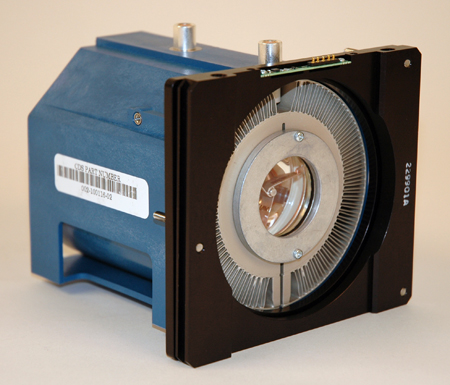Wolf in the Fold


Wolf's DCX line of 3-chip DLP projectors use large, commercial-grade DMD chips and are available in three lamp-power configurations—500, 1000, and 1500 watts. In addition, each model can be ordered "full dress" with a finished cabinet (DCX-FD) or without (DCX-i), which is more appropriate for custom installations where the projector will be hidden from view.

The DCX projectors employ xenon lamps, which are used in commercial projectors and are much more expensive than the UHP lamp used in most other consumer models. However, that expense can be easily justified by the xenon lamp's longer lifespan and closer match to the spectral distribution of natural sunlight. Wolf goes one step farther with a special lamp-intensity circuit that compensates for minute changes on the illuminating surface of the lamp over time, and xenon's wide power variability allows the calibrator to configure the projector for daytime and nighttime light levels.

No less important is the lens, which is the highest-quality glass available. To produce images at different aspect ratios with constant height, the DCX provides a feature called Variscope, a motorized lens that zooms in and out for material at 1.78:1, 1.85:1, 2.35:1 and 2.40:1 or anything in between while filling the screen vertically without scaling or additional anamorphic lens. This is exactly how commercial projectors accommodate different aspect ratios, but it is rare among consumer models. (The only other consumer projector I know of that does this is the Panasonic PT-AE3000U, but its lens is undoubtedly inferior to Wolf's. Hey, what do you expect for $3500?)

Variscope severely limits the distance at which the projector can be placed from the screen, since the zoom range is taken up with this function. So Wolf also offers an anamorphic-lens option called Variscope Ultra, which also uses the highest-grade optics and includes a motorized sled. In addition to allowing more flexible placement, it also extends the possible aspect ratios all the way to 2.70:1.

The DCX comes with an external controller/input switcher that works in conjunction with the projector's internal processor. This box provides six HDMI inputs and two HDMI outputs—one goes to the projector and the other goes to the audio system, a nice touch.

Of course, this level of performance doesn't come cheap. Baseline prices range from $65,000 for the DCX-500i to $117,000 for the DCX-1500FD, and Variscope Ultra is an extra $15,000. But each unit is custom built after determining the customer's specific needs, so if you've got the scratch, you won't be able to do much better than this.
- Log in or register to post comments




























































